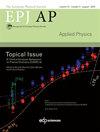蓝宝石低语走廊模式固态微波激射振荡器的物理学
IF 0.9
4区 物理与天体物理
Q4 PHYSICS, APPLIED
引用次数: 0
摘要
低温蓝宝石振荡器(CSO)是目前可用的最佳技术,可以提供优于10−15的相对频率稳定性,积分时间在1秒到10,000秒之间。但是,CSO仍然是一个复杂的仪器,需要多个环路控制来实现最佳的频率稳定性。在自维持的微波激射振荡器中使用蓝宝石谐振器的可能性为CSO提供了一个优雅的替代方案。在这里,维持放大是通过高q因子窃窃廊模式与顺磁性Fe3+离子之间的相互作用来实现的,这些离子在蓝宝石晶体中浓度很小。Fe3+离子表现出三种能态,可以实现自维持的固态脉泽。虽然这一原理在几年前就已经在实验中得到了证明,但它作为一种真正可用的超稳定源的发展尚未完成,主要原因是缺乏对所涉及的复杂物理现象的控制。本文是对前人基于速率方程模型的理论工作的补充。在这里,我们导出了描述蓝宝石晶格内Fe3+离子在泵浦和脉射信号下的演化的完整量子方程。指出了离子浓度和自旋弛豫时间的影响。本文章由计算机程序翻译,如有差异,请以英文原文为准。
Physics of the sapphire whispering-gallery-mode solid-state MASER oscillator
The Cryogenic Sapphire Oscillator (CSO) is currently the best available technology that can provide a relative frequency stability better than 10−15 with integration times between 1 s and 10,000 s. But, the CSO remains a complex instrument that requires multiple loop controls to achieve the best frequency stability. The possibility to use the sapphire resonator in a self-sustained MASER oscillator presents an elegant alternative to the CSO. Here, sustaining the amplification is achieved through the interaction between a high-Q factor whispering gallery mode and the paramagnetic Fe3+ ions, which are present in small concentration in the sapphire crystal. The Fe3+ ion exhibits three energy states enabling to realize a self-sustaining solid-state maser. Although, this principle has been already experimentally demonstrated few years ago, its development as a truly usable ultra-stable source has not yet been completed, mainly due to the lack of control of the complex physical phenomena involved. This paper complements the previous theoretical work based on the rate equations model. Here we derive the full quantum equations describing the evolution of the Fe3+ ions inside the sapphire lattice and submitted to a pump and a maser signal. The influence of the ions concentration and spin-spin relaxation time will be pointed out.
求助全文
通过发布文献求助,成功后即可免费获取论文全文。
去求助
来源期刊
CiteScore
1.90
自引率
10.00%
发文量
84
审稿时长
1.9 months
期刊介绍:
EPJ AP an international journal devoted to the promotion of the recent progresses in all fields of applied physics.
The articles published in EPJ AP span the whole spectrum of applied physics research.

 求助内容:
求助内容: 应助结果提醒方式:
应助结果提醒方式:


